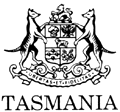Right to Information Regulations 2010
I, the Governor in and over the State of Tasmania and its Dependencies in the Commonwealth of Australia, acting with the advice of the Executive Council, make the following regulations under the Right to Information Act 2009 .
11 June 2010PETER G. UNDERWOOD
Governor
By His Excellency's Command,
LARA GIDDINGS
Minister for Justice
These regulations may be cited as the Right to Information Regulations 2010 .
These regulations take effect on 1 July 2010.
In these regulations –Act means the Right to Information Act 2009 ;applicant means the person who is making, or who has made, an application for an assessed disclosure;proof of identity means –(a) a certified copy, or an extract, of a birth certificate that shows the name of the applicant; or(b) a certified copy of a certificate, declaration, notice or other instrument in respect of the applicant's status as an Australian citizen or British subject, or otherwise in respect of the applicant's nationality, issued under –(i) the Australian Citizenship Act 2007 of the Commonwealth; or(ii) the Australian Citizenship Act 1948 of the Commonwealth; or(c) a passport, issued in any country or territory, that shows the name of the applicant; or(d) a drivers licence, issued in Australia, that shows the name of the applicant.
4. Minimum information to be contained in application for assessed disclosure
For section 13(3) of the Act, the minimum information that must be contained in an application for an assessed disclosure is as follows:(a) the name of the applicant;(b) the address of the applicant, for communication on matters relating to the application;(c) the daytime contact details of the applicant;(d) the general topic of the application;(e) details of the information sought by the applicant;(f) details of any efforts undertaken by the applicant, before the application was made, to obtain the information sought;(g) the date of the application;(h) the signature of the applicant;(i) if the application includes a request for personal information of the applicant, proof of identity of the applicant.
5. Minimum information to be provided to applicant by public authority
For section 13(5) of the Act, the minimum information that a public authority must provide to an applicant about the public authority's assessment procedure for applications for assessed disclosures is as follows:(a) an outline of the objects of the Act;(b) the address to which an application is to be made;(c) a statement to the effect that an application is to be made in writing;(d) the application fee payable under section 16 of the Act;(e) the time within which an application is to be decided;(f) a statement to the effect that an applicant may apply to the Ombudsman for a review, under section 45(1)(f) of the Act, of a decision, if the applicant has not received notice of the decision within the period specified in, or calculated under, section 15 .
For the definition of "corresponding law" in section 34(3) of the Act, the following laws are declared to be laws that correspond to the Act:(a) the Freedom of Information Act 1989 of the Australian Capital Territory;(b) the Freedom of Information Act 1982 of the Commonwealth;(c) the Government Information (Public Access) Act 2009 of New South Wales;(d) the Information Act of the Northern Territory;(e) the Right to Information Act 2009 of Queensland;(f) the Freedom of Information Act 1991 of South Australia;(g) the Freedom of Information Act 1982 of Victoria;(h) the Freedom of Information Act 1992 of Western Australia.
Displayed and numbered in accordance with the Rules Publication Act 1953.
Notified in the Gazette on 16 June 2010
These regulations are administered in the Department of Justice.
EXPLANATORY NOTE
(This note is not part of the regulation)
These regulations –(a) prescribe the minimum information that must be contained in an application for an assessed disclosure of information; and(b) prescribe the minimum information that a public authority must provide to an applicant about the assessment procedure for such an application; and(c) declare certain laws to be corresponding laws for the purpose of the Right to Information Act 2009 .

 Loading..
Loading..